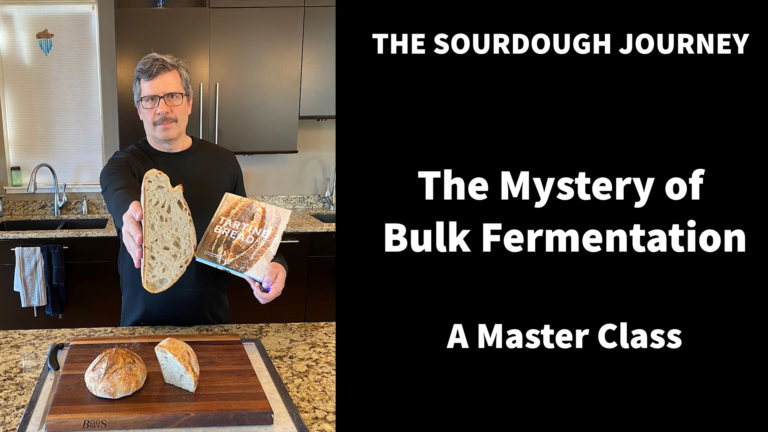This is an auto-generated transcript of the video: “The Mystery of Bulk Fermentation” from The Sourdough Journey. Copyright 2020. All Rights Reserved
The video can be found at https://youtu.be/nYCS5BFA_sM
so let’s talk about what’s actually
happening in bulk fermentation this is
one of the more complex parts of the
sourdough baking process in bulk
fermentation
there are basically three things
happening one is we’re building the
gluten structure two is we’re rising the
dough and three we’re developing the
flavor of the dough so how does this
work there are three members of the team
making all this happen number one to
build the gluten structure that’s your
job as the Baker
so as you stretch and fold the dough
stretching is building elasticity of the
glutens building the gluten structure
and then by folding the dough over
you’re basically building a matrix or a
grid of glutens that’s called building
the gluten structure I like to envision
that like this grid this cooling rack
the second thing that’s happening is the
yeast is filling up the grid with carbon
dioxide and that is rising the dough
that’s the job of the yeast so the yeast
basically eats sugar and starch and it
starts filling up each one of these
cells that you’ve created in the grid of
gluten in the matrix
the third thing that’s happening is the
lactic acid bacteria is also eating
sugars and starches that’s working in
the background and it is developing the
flavor of the dough so let’s talk about
an example where all these things go
properly and we’ll use the Tartine
example as our baseline so in the
Tartine recipe as we’ve talked about
when you build the gluten structure
that’s your job you do for stretching
folds so you complete destruction folds
you essentially build the grid the
second thing that happens is the lactic
acid bacteria is working in the
background developing the flavor and the
third thing that’s happening is the
yeast is doing the heavy lifting during
bulk fermentation so the yeast is
working at the perfect temperature so
you’ve created an environment between 78
and 82 degrees Fahrenheit that’s twenty
five point five to twenty seven point
eight degrees Celsius so the yeast can
do its job in that perfect warm
environment and it starts filling up the
grid
it works through the for our bulk
fermentation period that’s the
recommended time in the Tartine recipe
and at the end of four hours exactly the
yeast fills up the last cell in the grid
and the dough has risen by exactly
thirty percent that is nirvana that is
the holy grail of bulk fermentation is
when all those elements work perfectly
and it ends exactly on time and this is
an example of what nirvana looks like in
this type of recipe we’re baking a basic
country loaf you see a very nice dome
shaped loaf an even distribution of
small medium and large sized holes
evenly distributed throughout the crumb
this is a sign of very good bulk
fermentation when any of those things go
wrong you have two outcomes you have
under proofing or over proofing
so essentially what happens with under
proofing is the yeast can’t finish its
job for a variety of reasons so under
proofing is caused by three things the
first problem with under proofing is
that you don’t have sufficient gluten
structure so that’s where you basically
don’t do your job building the grid so
if the recipe calls for for stretching
folds and you only do – you just don’t
build the grid sufficiently so you’ve
built one half the size the yeast shows
up ready to do its job it starts filling
up the grid and it only gets to halfway
up and then it runs out of space to put
the co2 so the dough doesn’t rise so
typically with insufficient gluten
structure you will see a loaf like this
this is one of my early loaves this
you’ll tend to get a dense flat loaf the
second reason which is a little bit more
common that you will have under proofing
is due to a weak starter this is a very
common issue with brand new sourdough
bakers where you just built your starter
you’re anxious to do your first loaf and
you kind of rush that process you should
wait you know 10 to 14 days at least
before your starter has enough strength
to really carry the rise and a loaf but
a lot of people get impatient and they
rush it so you’ve sufficiently built
your grid through your four stretchin
folds and the bus pulls up with a weak
starter you’re expecting a million East
cells and because it’s a fairly immature
or new starter there are only 500,000
yeast cells in there it just can’t do
the job it gets halfway through the
build-up of the co2 halfway through the
rise and it just runs out of energy
because you didn’t have a large enough
population of the yeast to actually rise
the dough and fill the entire gluten
matrix another similar variation on this
and compared to a weak starter is where
you just don’t add enough starter for
the recipe this is an easy problem to
solve if the recipe calls for 200 grams
which this one does add 200 if you say I
didn’t make enough starter the night
before I didn’t make enough leaven I
only have
hundred grams of starter or eleven and
you try to do the recipe with a hundred
instead of 200 there’s not enough
population of the yeast to fill the grid
so again you’ll have under proofing due
to a weak or insufficient starter based
on quantity in that example so here’s an
example of what a loaf would look like
when you have a weak starter or
insufficient quantity of starter in this
example you can see the caverns inside
the crumb you can see the dense crumb at
the bottom and some separation of the
crumb from the crust these are signs of
a weak starter very common to see in
loaves for people first getting in the
sourdough baking when your starter is
just not up to sufficient strength the
third reason that you have under
proofing and this is absolutely the most
common is that you either have too low
of a temperature during bulk
fermentation too short of a time during
bulk fermentation or combination of both
so we’re going to talk about all these
together so with the problem of low
temperature you’ve sufficiently built
your grid of gluten the yeast shows up
and their appropriate quantity to do the
job but the temperature is too low and
the yeast really needs to be in that 78
to 82 degree fahrenheit range in order
to finish block fermentation in four
hours per this recipe so if your kitchen
is cool and you just decide to leave it
on your countertop during bulk
fermentation and your temperature is 69
degrees Fahrenheit for example the yeast
just works more slowly and it can’t fill
the grid in the time that you’re
allowing for our time so you’ll
understand low temperature similarly you
can under proof based on too short of a
time so this recipe calls for a
four-hour block fermentation time the
yeast shows up ready to go the
temperature is perfect you have 80
degree temperature you’ve created a
proofing chamber you’ve put it in your
oven with the light turned on so your
yeast is flying through the process at a
perfect pace it’s ready to go
but you mistime something and you have
to cut off all commentation at three
hours instead of four hours the yeast
can’t finish its job because you didn’t
enough time so by having too short of a
bulb fermentation time you’ll have under
proofing the good thing about all of
these examples is the dough tells you if
it’s under proofed
because it doesn’t rise so in this
example we’re looking for a 30% rise in
volume and if any of those three things
happened
insufficient gluten structure weak
starter or too small of a starter
quantity too short of a time or too
short of a temperature the dough just
won’t rise so you so you can visibly see
that your dough will be under proofed
because it won’t hit that 30% mark so
here are two examples of what under
proofed dough looks like when you have
too low of a temperature or too low of a
time these were two recent bakes that I
had done one was where I intentionally
cut the time short to see what was the
quickest time that I could could finish
bulk fermentation in and you can see
here this loaf is seriously under
proofed
because there are large holes in the
crumb they tend to rise towards the top
of the crumb and you see the dense crumb
at the bottom this one was close
but it’s definitely under proofed
another example is where you weren’t
even in the ballpark with a very very
seriously under proofed loaf you’ll see
these telltale signs of under proofing
which are the tunnels at the top of the
loaf and the dense crumb at the bottom
of the loaf
that’s Cirrus under proofing very common
very common for beginners and those are
the tell-tale signs of that but just
remember that when you’re thinking about
am i under proofing the dead giveaway is
did the dough rise if the dough didn’t
rise there’s a pretty good chance that
you’re under proofing
so what happens with over proofing with
over proofing
there are three common things that
happen one is you add too much starter
again this is easy the recipe calls for
200 grams you should add 200 grams some
people try to speed things up and they
say I don’t have enough time so I’m
gonna try to do this quicker you add 300
grams it definitely will speed up your
bulk fermentation process and sometimes
it will run away from you and it’s very
difficult to predict what the impact of
adding more starter will be to a recipe
that calls for example in this case
three or four hour while fermentation
time if you add 300 grams of starter
instead of two it may be done in two
hours it may be done in two and a half
hours it’s very very difficult to
predict
so basically follow the recipe and don’t
try to overshoot the amount of starter
because the fermentation time can run
away from you the second thing that
happens is the temperature is too warm
so in this example we’ve created a
proofing chamber for example a lot of
people use their oven with the light on
and you don’t happen to check the
temperature you just say a lot of people
do this so I’m going to do it so I take
my ado after the stretching fold I put
it in the oven with the light on and the
temperature in there in my oven will
actually get up to 95 degrees just with
the oven light on no heat turned on in
the oven so the yeast is is sitting here
waiting to start its job at 78 to 82
degrees it starts moving moving filling
up the grid and all of a sudden the
temperature goes up to 95 degrees and
the yeast goes crazy so you’re looking
at your timer waiting for four hours for
bulk fermentation to be done and the
yeast is already done at say two and a
half hours or three hours it already
filled the grid because it was working
so fast at that high temperature so what
happens when the yeast kind of gets at
the top it’s filled up the grid it just
keeps pumping air into the the grid and
it will start bursting the gluten
strands so it’s like balloons
it just keeps blowing up the balloons
and the balloons start bursting all over
and that starts to deflate the
the second thing that happens with high
temperature is you also start to
activate the lactic acid bacteria which
we didn’t really talk about an under
proofing because it’s worked in the
background that’s staying out of the way
of the yeast when you start to get the
temperature up above say 90 degrees the
lactic acid bacteria loves the high
temperatures so that lactic acid
bacteria will show up it will start
consuming the starches and sugars that
were meant for the yeast they start
competing for the same food sources the
yeast starts slowing down our not
optimizing its process and after all the
starches and sugars in the vicinity are
gone the lactic acid bacteria will eat
the grid it will actually eat the gluten
and start to break down the gluten so
what happens with these high temperature
over proofs is you take your dough out
of the bowl you pour it onto the counter
top to do your dividing and pre shaping
and it looks like a giant pile of
ricotta cheese it’s it’s a slushy
looking mess of dough it’s it flattens
out it’s liquefied you can see the
gluten strands in it that’s the dead
giveaway of over proofing based on
temperature similarly the third aspect
of over proofing is too much time and
again almost the exact same thing
happens the temperature might be perfect
but instead of stopping bulk
fermentation at four hours when the
yeast fills up the grid you let it go
for five hours you let it go for six
hours the dough keeps inflating
inflating the yeast starts bursting the
bubbles the lactic acid bacteria starts
to eat the grid and you end up with the
same issue your gluten structure is now
broken down because the lactic acid
bacteria and the yeast went past that
optimal optimal point and they start to
break down the structure of the dough
here’s what an example of an over
proofed loaf looks like you basically
you lose the structure of the loaf the
loaf starts to flatten out the gluten
starts to pull away from the crust and
here’s an extreme example called the
flying
where the gluten is so weak that the
crust detaches from the crumb and you
get this giant cavern inside the crumb
because the gluten has no strength the
gluten has been broken down by the
lactic acid bacteria consuming it and by
the yeast over stretching it because the
yeast had too much time on its hands so
it just keeps filling and filling and
filling the dough which ultimately
bursts the bubble membranes
and the last thing that can happen in
bulk fermentation that’s not under
proofing or over proofing it could
happen in either of those scenarios is
over handling over handling of the dough
is basically where you inject yourself
into the process and you do more gluten
development what you think is gluten
development than what was called for in
the recipe so in this example the
Tartine recipe calls for for stretch and
folds and you might say I really like
the feel of the dough I like doing the
stretch and fold I’m just gonna do eight
of them or I’m gonna do ten stretching
folds when you start to do that you’re
overworking the dough so when the yeast
shows up and gets ready to fill the grid
you’ve done it so much that you put
another grid on top of it and now
there’s double or triple the number of
cells in the matrix so instead of a
light airy crumb with these big balloons
that the yeast can fill up you’ve
created these tiny cells of gluten so
now the yeast is just filling up all
these tiny cells because there are two
times or three times more of them the
other thing that happens with over
handling is that some people go beyond
the stretch and fold process because
they’re familiar with baking bread using
traditional commercial yeast and they’ll
start kneading the dough or they’ll put
the dough in there and their power mixer
countertop mixer and what happens there
in addition to creating the dense crumb
because you’re just overworking the
dough with more energy with more of that
strength you actually start to rip the
gluten strands so now you’ve just
destroyed the grit the perfectly set up
grid that you created instruction fold
if you start kneading the dough you just
start ripping this to shreds so the
yeast shows up ready to do its job and
half of the balloons that it’s trying to
blow up have already burst you already
ripped the balloons so you get a dentist
Crum you don’t get the rise in the dough
when you over handle the dough here’s an
example of what over handle dough looks
like you can see very very dense crumb
and that’s usually caused by human
intervention
into the process where you just keep
working the dough more than you need to
so how do you avoid issues with block
fermentation number one follow the
recipe add the appropriate amount of
strong starter that’s called for in the
recipe number to monitor the time and
temperature of your dough during bulk
fermentation so many people try to guess
at this you really don’t need to do that
measure the temperature monitor the time
let the science take a lot of the
variability out of the equation for you
so that then all you’re looking at is
the percent rise at the end and you’re
not guessing about what was the
temperature of my dough
very very easy thing to fix and a common
problem that a lot of beginners make is
not measuring the temperature and the
time during bulk fermentation and lastly
don’t over handle the dough there’s
always a temptation to want to be doing
more handling than is required I would
say to challenge yourself the next time
you bake a loaf to say if I strictly
follow the recipe what’s the minimum
amount of time that I need to be
touching the dough and try that one time
and see if your result is different
especially if you’re having issues with
over handling so that was a deep dive
into the topic of bulk fermentation over
proofing and under proofing if you’re
interested in this I have another video
in the series that I made called over
proofing or under proofing a tale of
four loaves where I actually go through
and bake for different loaves and modify
the bulk fermentation time across those
loaves and then demonstrate the impact
on the loaves you might find that
interesting as well
Tom Cucuzza
Understanding Bulk Fermentation
Share:
Facebook
Twitter
Pinterest
Print
Email
On Key
Related Posts
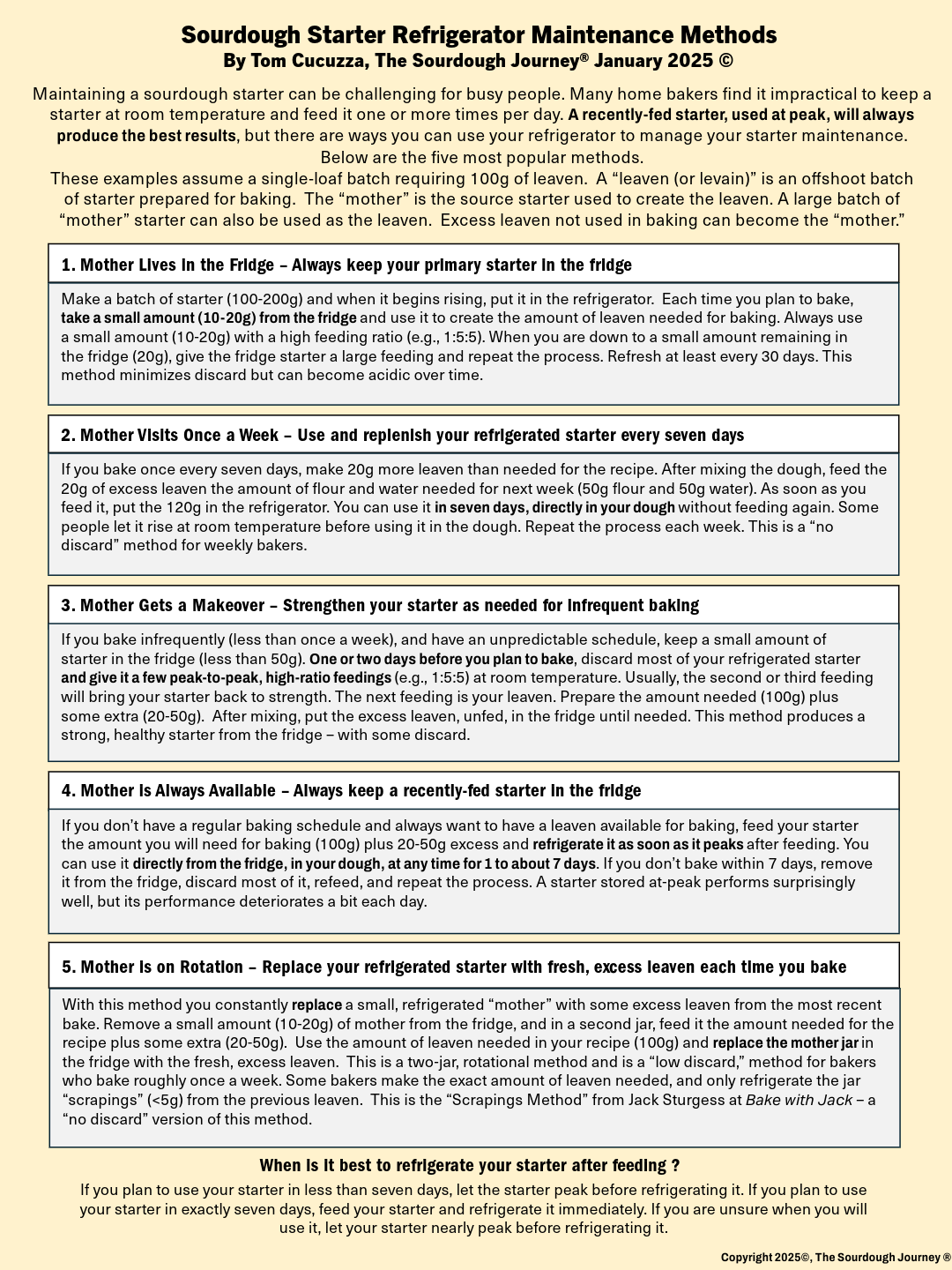
Sourdough Starter: Refrigeration Maintenance Methods
How can I maintain my sourdough starter in the refrigerator instead of at room temperature?
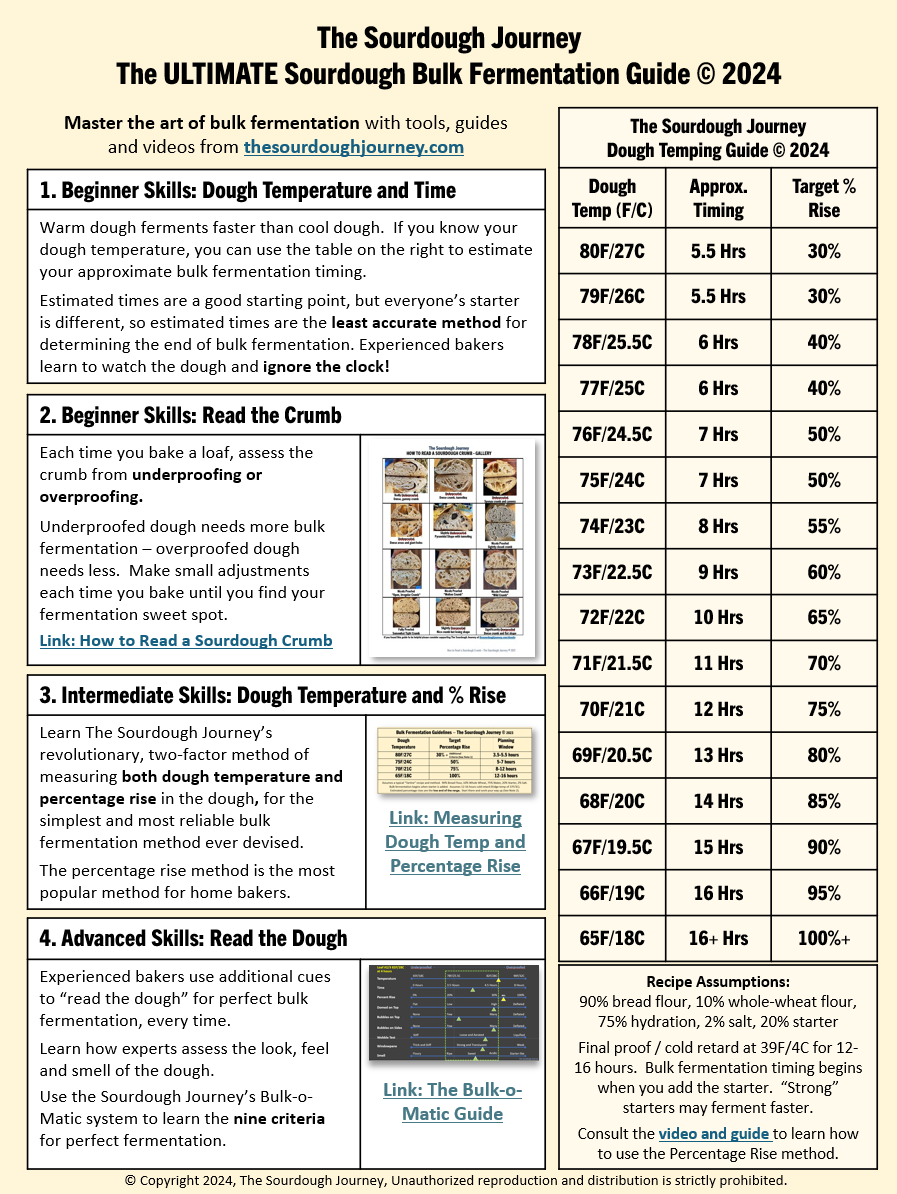
The ULTIMATE Sourdough Bulk Fermentation Guide
When is sourdough bulk fermentation finished?

Dough Temping for PERFECT Sourdough Fermentation
What is sourdough “dough temping,” and how does it work?
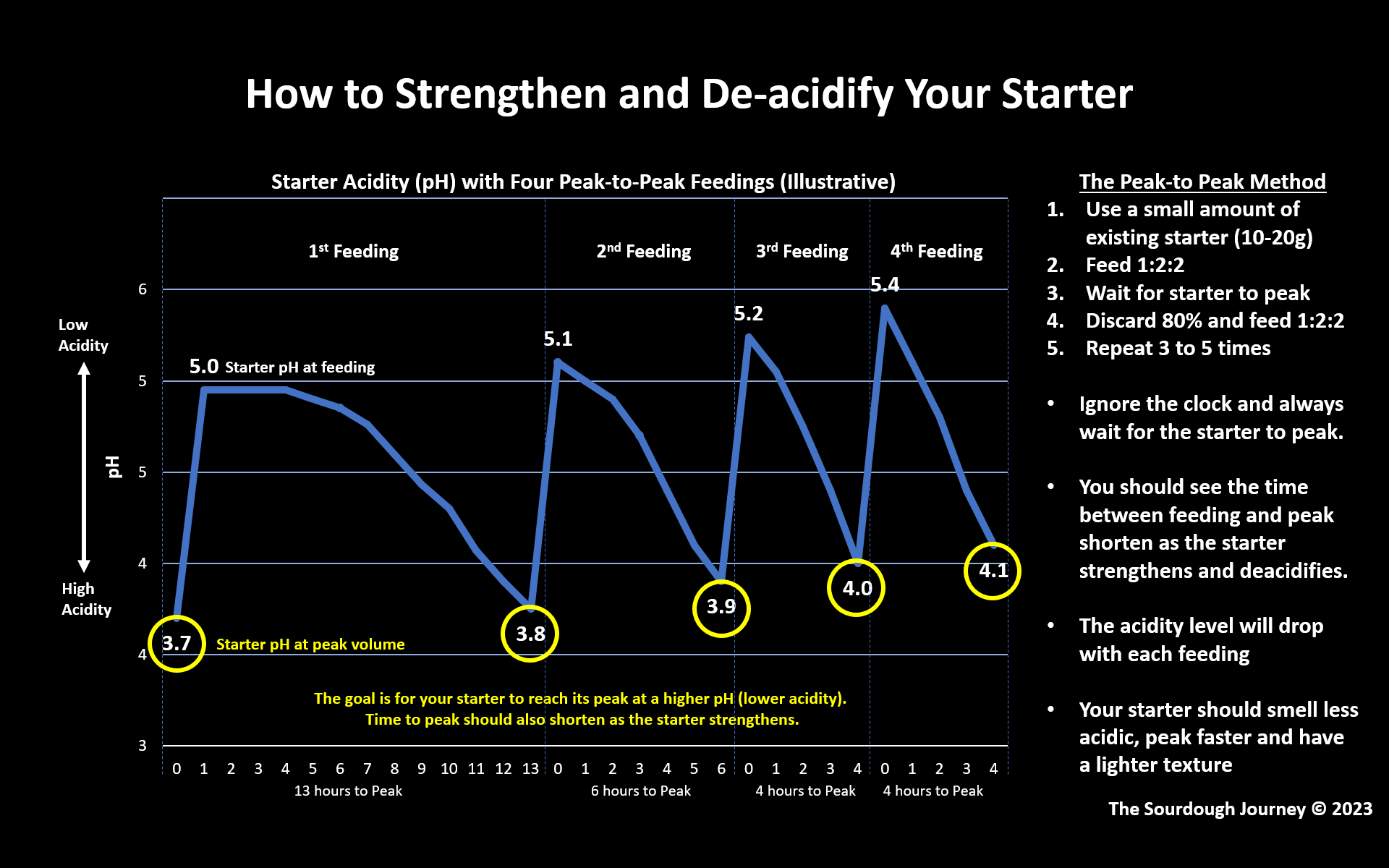
The Science of the Peak-to-Peak Method of Strengthening a Sourdough Starter
What is the Peak-to-Peak Method and how does it strengthen a weak sourdough starter?
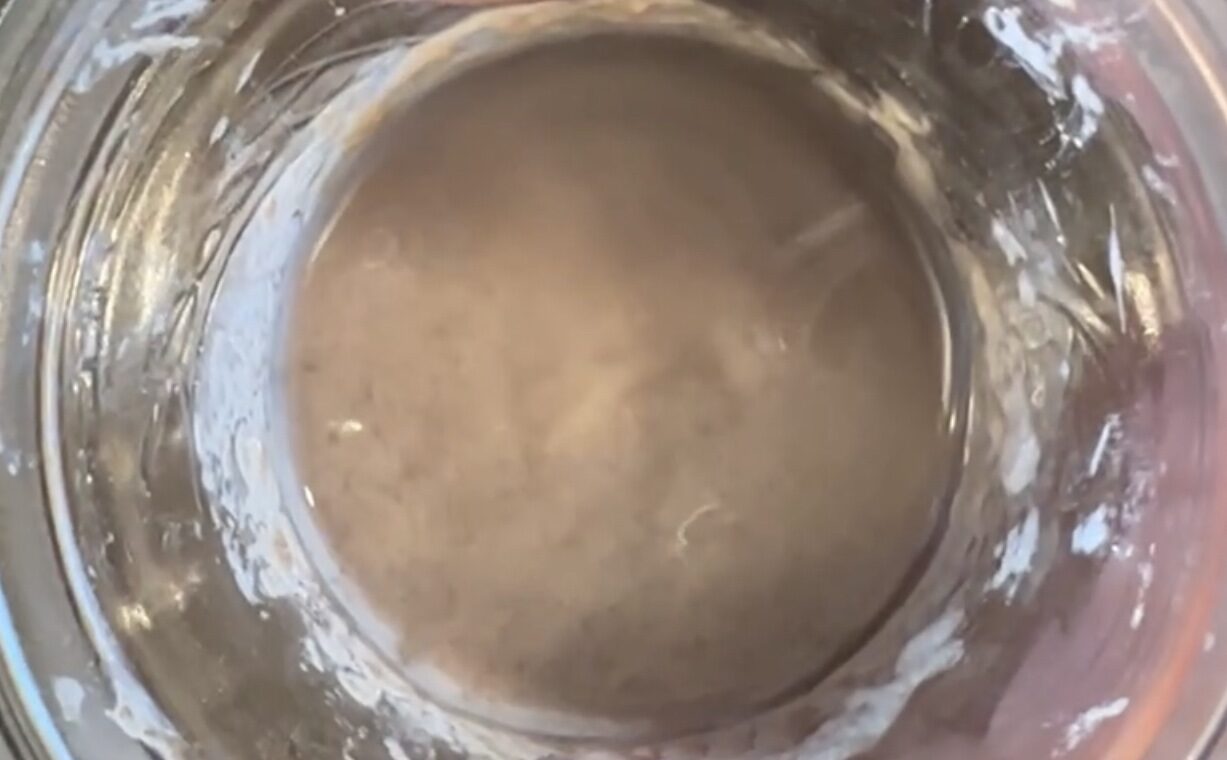
How to Strengthen a Weak, Acidic Starter
Is your sourdough starter sluggish? How do you identify and fix a weak, acidic starter. This document is the companion guide to the popular video “How to Strengthen a Weak, Acidic Starter.”

